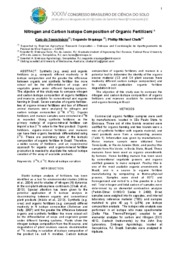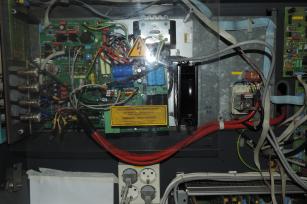Nitrogen and carbon isotope composition of organic Fertilizers.
Nitrogen and carbon isotope composition of organic Fertilizers.
Author(s): INACIO, C. de T.; CABALLERO, S. S. U.; CHALK, P. M.
Summary: Synthetic (e.g. urea) and organic fertilizers (e.g. compost) differed markedly in N isotope composition and the greater the difference between organic and synthetic fertilizer the more robust will be the differentiation of crops and vegetable grown under different farming systems. The objective of this study was to compare nitrogen and carbon isotope composition of organic fertilizers and manures available for conventional and organic farming in Brazil. Seven samples of organic fertilizer, two of organo-mineral fertilizers and two of different animal manures were analyzed for nitrogen and carbon isotope composition (15N, 13C). Organic fertilizers and manure samples were enriched in 15N as expected. Using synthetic fertilizers as the primary material of organo-mineral fertilizer can imprint a low 15N value to the final product. Organic fertilizers, organo-mineral fertilizers and manures can have their organic feedstock differentiated using 13C. These are preliminary data of the isotopic composition of organic fertilizer in Brazil. Therefore, a wider survey of fertilizers and an experimental approach for organic- and organo-mineral fertilizer production is needed to elucidate the natural isotope variation of the array of available products.
Publication year: 2013
Types of publication: Paper in annals and proceedings
Unit: Embrapa Soils
Keywords: 13C, 15N, Natural isotope variation
Observation
Some of Embrapa's publications are published as ePub files. To read them, use or download one of the following free software options to your computer or mobile device. Android: Google Play Books; IOS: iBooks; Windows and Linux: Calibre.
Access other publications
Access the Agricultural Research Database (BDPA) to consult Embrapa's full library collection and records.
Visit Embrapa Bookstore to purchase books and other publications sold by Embrapa.


